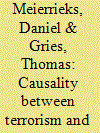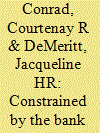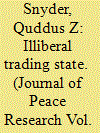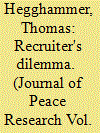|
|
|
Sort Order |
|
|
|
Items / Page
|
|
|
|
|
|
|
| Srl | Item |
| 1 |
ID:
121789


|
|
|
|
|
| Publication |
2013.
|
| Summary/Abstract |
The primary purpose of many alliances is to deter attacks on members of the alliance by potentially antagonistic states. Yet some alliances can increase the probability of conflict that may be initiated by alliance members. Cognizant of that possibility, states that wish to sustain peace may nevertheless intentionally form alliance commitments with revisionist leaders of other states. Faced with the partially conflicting goals of deterring antagonistic states while at the same time restraining allies, leaders often include in alliance treaties conditions that oblige allies to provide military assistance only if a member of the alliance is attacked by a state outside the alliance. However, other treaties may contain unconditional obligations to come to the defense of members of the alliance. Such alliances tend to arise from situations where some members of the alliance feel that their alliance partners need to have the flexibility even to engage in provocative behavior in order to deter the target of the alliance. Our analysis of alliance formation processes in the context of priorities that compete with each other provides a basis for two hypotheses. The first is that revisionist states with unconditional commitments from members of their alliance to come to their defense are more likely to initiate militarized conflict than states without such unconditional commitments. The second hypothesis is that revisionist states in alliances whose treaties stipulate that commitments to defend are conditional will be less likely to initiate militarized conflict than such states with allies who are committed to come to their defense without conditions. Statistical analyses of data generated with a view toward evaluations of both hypotheses (some of which provide new, more detailed categorizations of alliance treaties) suggest that they are valid.
|
|
|
|
|
|
|
|
|
|
|
|
|
|
|
|
| 2 |
ID:
121792


|
|
|
|
|
| Publication |
2013.
|
| Summary/Abstract |
This article analyzes the causal relationship between terrorism and economic growth, running a series of tests for Granger non-causality with panel data for a maximum of 160 countries from 1970 to 2007. The authors find that the causal relationship between terrorism and growth is heterogeneous over time and across space. They argue that the temporal causal heterogeneity can be explained by shifting geographical and ideological patterns in terrorism associated with the end of the Cold War. Different causal mechanics across countries are ascribed to a variety of country-specific factors (the level of politico-economic development, a country's cultural affiliation, the intensity and persistence of terrorist activity, and the level of political instability). These factors govern a country's robustness to shocks from terrorism and the extent to which terrorism is motivated by economic factors. For the Cold War era, economic growth is found to have swayed terrorism for Latin American countries in intermediate development positions that were politically unstable and experienced strong terrorist activity. For the post-Cold War era, terrorism is found to be detrimental to growth for African and Islamic countries with low levels of political openness, high levels of political instability, and strong terrorist activity. The study's findings help to better understand the conflicting evidence on the terrorism-economy nexus and to give more solid counter-terrorism advice.
|
|
|
|
|
|
|
|
|
|
|
|
|
|
|
|
| 3 |
ID:
121793


|
|
|
|
|
| Publication |
2013.
|
| Summary/Abstract |
Why does the discovery of oil lead to increased government repression in some countries and not others? Why is there variance in the extent to which democracy constrains state violations of human rights? We assume that an executive's propensity to use violence against citizens is a function of the extent to which he is dependent on his citizenry. Executives can be dependent on their citizenry in two ways: (1) at the bank for financial resources, and (2) at the ballot box for political support. We argue that these considerations jointly influence executive decisions to engage in state repression, and consequently, observed human rights abuse. Using a dataset of 146 countries from 1981 to 2011, we find that democratic institutions have a moderating effect on the positive relationship between unearned revenues and human rights violations. Decreased reliance on citizens for revenue does not weaken and may actually strengthen the pacifying effect of democratic institutions on state terror. Our results suggest that pursuing democracy is a useful way to reduce political violence, both directly and indirectly, even in the presence of a resource curse. Furthermore, the discovery of oil and other unearned revenues is unlikely to undermine the positive relationship between democratic institutions and domestic protections for human rights.
|
|
|
|
|
|
|
|
|
|
|
|
|
|
|
|
| 4 |
ID:
121794


|
|
|
|
|
| Publication |
2013.
|
| Summary/Abstract |
Economic sanctions have been referred to as a blunt instrument that the international community has often wielded without full consideration of the impact that these measures will have on the population of the targeted countries, particularly the weakest elements of society. Case studies of sanctions against Cuba, Iraq, and Yugoslavia have demonstrated the impact that sanctions can have on the availability of food, clean water, and medicine, causing many to conclude that all sanctions have extensive public health consequences. In this article, we examine the generalizability of these conclusions in a quantitative cross-national study of sanctions and their public health effects. Additionally, we compare these effects to those associated with both civil and interstate conflicts as critics have recently suggested that sanctions are not a humane alternative to armed warfare. We find that when sanctions have a large economic effect on the target they can have severe public health consequences. These consequences are substantively similar to those associated with major military conflicts. However, when sanctions have little or no economic effect on the target, they also have no substantive effect on public health. Building on recent work to explore the human consequences of war, this work also helps to demonstrate the importance of smart sanctions and humanitarian exemptions in sanctions policy.
|
|
|
|
|
|
|
|
|
|
|
|
|
|
|
|
| 5 |
ID:
121787


|
|
|
|
|
| Publication |
2013.
|
| Summary/Abstract |
Prediction is an important goal in the study of international conflict, but a large body of research has found that existing statistical models generally have disappointing predictive abilities. We show that most efforts build on models unlikely to be helpful for prediction. Many models essentially ignore the origins of conflict; studies look either at invariant structural features believed to affect the opportunities of conflict, or at factors that are believed to reduce the baseline risk of conflict, without attempting to identify the potential motivations and contentious issues over which conflicts typically arise. Researchers that have considered how contentious issues may motivate conflict and how these can be managed, using the Issues Correlates of War (ICOW) data, have not considered how these features may inform prediction. We assess the risk of dyadic interstate conflict based on the presence of specific contentious issues and conflict management events that may change the conflict potential of these contentious issues. We evaluate to what extent incorporating contentious issues and conflict management can help improve out-of-sample forecasting, as well as advance our understanding of conflict dynamics. Our results provide strong support for the idea that taking into account contentious issues can inform and improve out-of-sample forecasting.
|
|
|
|
|
|
|
|
|
|
|
|
|
|
|
|
| 6 |
ID:
121788


|
|
|
|
|
| Publication |
2013.
|
| Summary/Abstract |
Liberal systemic theory is built on the assumption that the system's dominant configuration is a Kantian confederation of major powers. In addition to being a democratic cluster, the liberal core is also a capitalist club. This article pushes systemic and socialization theory forward by introducing the mechanism of economic competition as an important driver of socialization. The article develops a theory of system-level competition, arguing that it is a distinct and co-equal mechanism of socialization to the established mechanisms of persuasion, inducement, and coercion. The article proposes a three-staged model of socialization that explains how prominent rising powers such as Turkey, India, Brazil, and China are being socialized into the liberal system. At the first phase, competitive pressure, outsiders are led to orient themselves toward the core out of a fear of falling behind and a desire to access network benefits. At the second phase, rushing, outsiders behave in pro-norm ways and make significant concessions in order to gain inclusion in the core's institutional complex. At the third phase, internalization, external norms become embedded in domestic legal institutional structures and a robust pro-norm domestic coalition emerges. The article uses the case of China to illustrate the model and lend it some initial empirical support in one hard case.
|
|
|
|
|
|
|
|
|
|
|
|
|
|
|
|
| 7 |
ID:
121786


|
|
|
|
|
| Publication |
2013.
|
| Summary/Abstract |
How do terrorists recruit? We know much about the profiles and pathways of recruits, but little about the strategies and tactics of recruiters. Such procedures matter because they help determine who joins. I highlight a key determinant of recruiter tactics, namely, the tension between personnel needs and infiltration risks. Drawing on signalling theory, I present an analytical framework that conceptualizes recruitment as a trust game between recruiter and recruit. I argue that the central logic shaping recruiter tactics is the search for cost-discriminating signs of trustworthiness. Due to the context-specificity of signal costs and the room for tactical innovation, optimal recruitment tactics vary in space and time, but the underlying logic is the same for most groups facing a high threat of infiltration. I apply the framework to an al-Qaeda recruitment campaign in early 2000s Saudi Arabia, where it helps explain tactical preferences (why recruiters favoured some recruitment arenas over others) and differential network activation (why recruiters preferred war veterans over radical candidates from other networks). The trust dilemma also accounts for unexpected recruiter choices, such as their reluctance to solicit on the Internet and in mosques, and their preference for recruits who knew poetry or wept during prayer. Thus the signalling framework does not challenge, but provides a useful micro-level complement to, existing theories of recruitment.
|
|
|
|
|
|
|
|
|
|
|
|
|
|
|
|
| 8 |
ID:
121791


|
|
|
|
|
| Publication |
2013.
|
| Summary/Abstract |
Terrorists choose from a wide variety of targets and attack methods. Unlike past literature, this article investigates how diversity in target choice and attack modes among domestic and transnational terrorists has evolved and changed over the past 40 years. Changes in the practice of homeland security, which affects the marginal costs of target-attack combinations, and changes in the dominant terrorist influence at the global level, which affects the marginal benefits of target-attack combinations, drive the changepoints. Our empirical analysis relies on count data drawn from the Global Terrorism Database (GTD) for 1970-2010 that distinguishes between domestic and transnational terrorist incidents. Given the data-intensity requirements of our methods, the study is necessarily from a global perspective. A Bayesian Reversible Jump Markov chain Monte Carlo (RJMCMC) changepoint analysis is applied to identify arrival rate changes in both domestic and transnational terrorism. The changepoints in these aggregate series are then matched with those of the subset time series for attack modes (e.g. assassinations and bombings) and target types (e.g. officials and private parties). The underlying drivers of these changepoints are then identified. The article also calculates a Herfindahl index of attack diversity for the aggregate and component domestic and transnational terrorism time series for the entire period and during four subperiods. The variation in both domestic and transnational terrorist attacks has generally fallen over the last four decades; nevertheless, this diversity still remains high. Bombings of private parties have become the preferred target-attack combination for both transnational and domestic terrorists. This combination is the hardest-to-defend target-attack combination and requires the most homeland security resources. Policymakers can use these and other results to focus their counter-terrorism measures.
|
|
|
|
|
|
|
|
|
|
|
|
|
|
|
|
| 9 |
ID:
121790


|
|
|
|
|
| Publication |
2013.
|
| Summary/Abstract |
Protection of civilians is now at the forefront of the responsibilities of the international community. There is a strong international norm that civilian populations should be protected from violence. But how committed is the United Nations to acting in line with this norm? I argue that the UN Security Council (UNSC) has an interest in demonstrating that it takes violence against civilians seriously. Through a broadened security agenda including human security, the legitimacy and the credibility of the UNSC hinges on its ability to act as a guarantor of civilian protection. As a consequence, the UN is more likely to deploy peace operations in conflicts where the warring parties target the civilian population. The argument is supported by a statistical examination of all internal armed conflicts in 1989-2006. The results show that the likelihood of a UN peace operation is higher in conflicts with high levels of violence against civilians, but this effect is mainly visible after 1999. This year marked a shift in the global security agenda and it was also when the UNSC first issued an explicit mandate to protect civilians. Conflicts with high levels of violence against civilians are also more likely to get operations with robust mandates. This suggests that the UNSC is not just paying lip service to the protection norm, but that it actually acts to implement it.
|
|
|
|
|
|
|
|
|
|
|
|
|
|
|
|
|
|
|
|
|